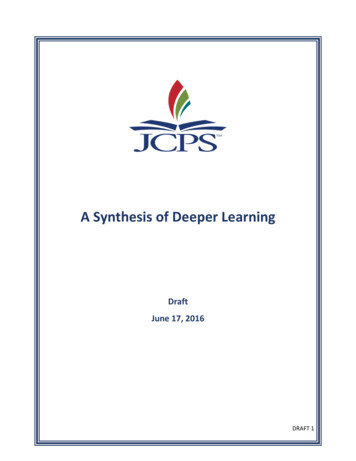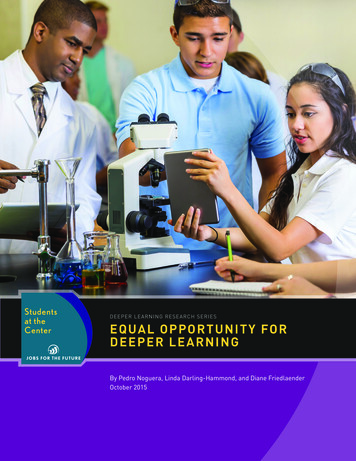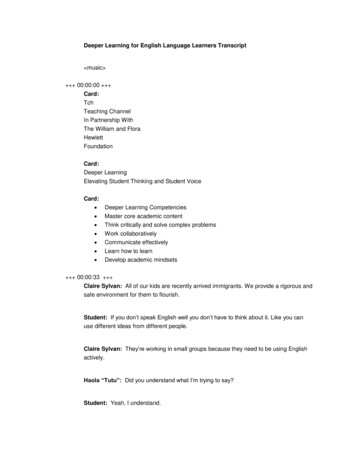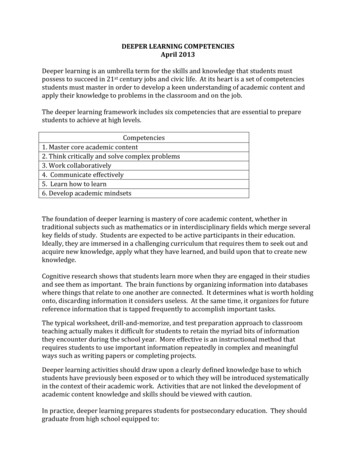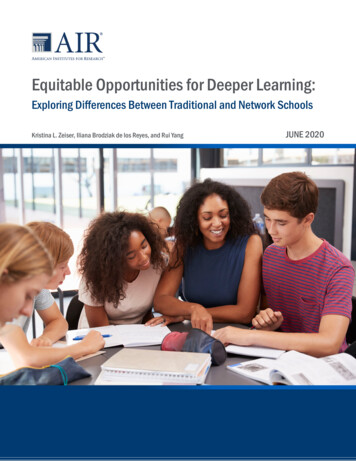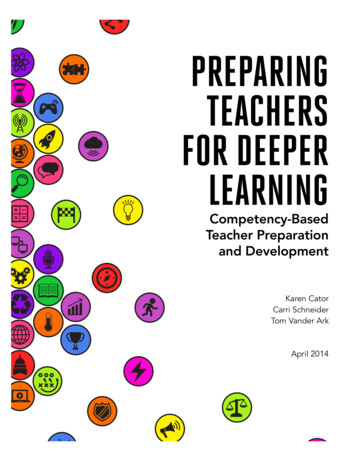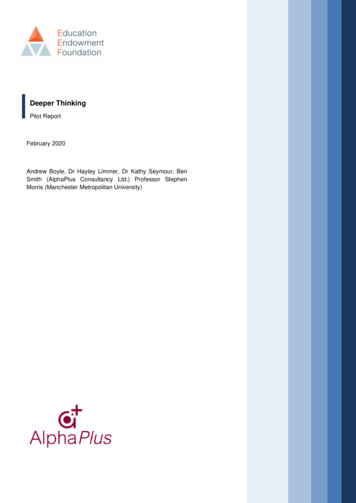
Transcription
A Deeper Understanding of EnergyA Deeper Understanding of EnergyCurriculum ConnectionsALBERTA, NORTHWEST TERRITORIES, NUNAVUT—Physics 20: CircularMotion, Work and Energy and Physics 30: Atomic PhysicsNote: These curriculum connections are meant to be a quick reference guide only. If you have anysuggestions for additional curriculum connections, or if you are aware of changes in your curriculum,please contact outreach@perimeterinstitute.ca.Physics Curriculum Connections (Physics 20 and Physics 30)(2007, updated 2014)Activity 1: The Conservation and Transformation of EnergyPhysics 20—Unit C: Circular Motion, Work and EnergySpecific Outcomes for Knowledge20-C2.1k define mechanical energy as the sum of kinetic and potential energy20–C2.3k analyze, quantitatively, kinematics and dynamics problems that relate to the conservation ofmechanical energy in an isolated system20–C2.4k recall work as a measure of the mechanical energy transferred and power as the rate of doing work20–C2.5k describe power qualitatively and quantitatively20-C2.6k describe, qualitatively, the change in mechanical energy in a system that is not isolatedSpecific Outcomes for Skills (Nature of Science Emphasis)Initiating and Planning20–C2.1s formulate questions about observed relationships and plan investigations of questions, ideas,problems and issues design an experiment to demonstrate the conservation of energy; e.g., Is energy conserved in a collision?(IP–NS1, IP–NS2)Performing and Recording20–C2.2s conduct investigations into relationships among observable variables and use a broad range of toolsand techniques to gather and record data and information perform an experiment to demonstrate the law of conservation of energy (PR–NS3) research the development of the law of conservation of energy, using library and Internet sources (PR–NS1)[ICT C1–4.1]1
A Deeper Understanding of EnergyAnalyzing and Interpreting20–C2.3s analyze data and apply mathematical and conceptual models to develop and assess possible solutions use free-body diagrams to organize and communicate solutions to work-energy theorem problems (AI–NS1) solve, quantitatively, kinematics and dynamics problems, using the work-energy theorem (AI–NS3)[ICT C6–4.1] analyze data to determine effective energy conservation strategies; e.g., analyze whether lowering the speedlimit or modifying the internal combustion engine saves more energy in vehicles (AI–ST2, AI–SEC3)[ICT C7–4.2]Communication and Teamwork20–C2.4s work collaboratively in addressing problems and apply the skills and conventions of science incommunicating information and ideas and in assessing resultsAttitude OutcomesInterest in Scienceshow interest in science-related questions and issues and confidently pursue personal interests and careerpossibilities within science-related fields; e.g., research the answers to questions they generateexplore and use a variety of methods and resources to increase their knowledge and skillsbe critical and constructive when considering new theories and techniquesuse scientific vocabulary and principles in everyday discussionsrecognize the usefulness of being skilled in mathematics and problem solvingScientific Inquiryseek and apply evidence when evaluating alternative approaches to investigations, problems and issues; e.g., ask questions and conduct research to ensure understanding expend the effort and time needed to make valid inferencesCollaborationwork collaboratively in planning and carrying out investigations and in generating and evaluating ideas; e.g., provide the same attention and energy to the group’s product as they would to a personal assignmentSafetyshow concern for safety in planning, carrying out and reviewing activities, referring to the Workplace HazardousMaterials Information System (WHMIS) and consumer product labelling information; e.g., manipulate materials carefully, being cognizant of the risks and consequences of their actionsActivity 2: Innovative TechnologiesPhysics 20—Unit C: Circular Motion, Work and EnergySpecific Outcomes for Knowledge20–C2.3k analyze, quantitatively, kinematics and dynamics problems that relate to the conservation ofmechanical energy in an isolated system20–C2.4k recall work as a measure of the mechanical energy transferred and power as the rate of doing work20–C2.5k describe power qualitatively and quantitatively2
A Deeper Understanding of EnergySpecific Outcomes for Science, Technology and Society (STS) (Nature of Science Emphasis)Specific Outcomes for Knowledge20–C2.2sts explain that the products of technology are devices, systems and processes that meet given needs;however, these products cannot solve all problems (ST6) [ICT F3–4.1]Specific Outcomes for Skills (Nature of Science Emphasis)Initiating and Planning20–C2.1s formulate questions about observed relationships and plan investigations of questions, ideas,problems and issues design an experiment to demonstrate the conservation of energy; e.g., Is energy conserved in a collision?(IP–NS1, IP–NS2)Performing and Recording20–C2.2s conduct investigations into relationships among observable variables and use a broad range of toolsand techniques to gather and record data and information perform an experiment to demonstrate the law of conservation of energy (PR–NS3) research the development of the law of conservation of energy, using library and Internet sources (PR–NS1)[ICT C1–4.1]Analyzing and Interpreting20–C2.3s analyze data and apply mathematical and conceptual models to develop and assess possible solutions use free-body diagrams to organize and communicate solutions to work-energy theorem problems (AI–NS1) solve, quantitatively, kinematics and dynamics problems, using the work-energy theorem (AI–NS3)[ICT C6–4.1] analyze data to determine effective energy conservation strategies; e.g., analyze whether lowering the speedlimit or modifying the internal combustion engine saves more energy in vehicles (AI–ST2, AI–SEC3)[ICT C7–4.2]20–C2.4s work collaboratively in addressing problems and apply the skills and conventions of science incommunicating information and ideas and in assessing resultsAttitude OutcomesInterest in Scienceshow interest in science-related questions and issues and confidently pursue personal interests and careerpossibilities within science-related fields; e.g., research the answers to questions they generate use scientific vocabulary and principles in everyday discussions recognize the usefulness of being skilled in mathematics and problem solvingMutual Respectappreciate that scientific understanding evolves from the interaction of ideas involving people with differentviews and backgrounds; e.g., explore personal perspectives, attitudes and beliefs toward scientific and technological advancements recognize the contribution of science and technology to the progress of civilizations show support for the development of technologies and science as they relate to human needs3
A Deeper Understanding of EnergyScientific Inquiryseek and apply evidence when evaluating alternative approaches to investigations, problems and issues; e.g., insist on evidence before accepting a new idea or a new explanationassess, critically, their opinion of the value of science and its applicationsevaluate inferences and conclusions, being cognizant of the many variables involved in experimentationask questions and conduct research to ensure understandingCollaborationwork collaboratively in planning and carrying out investigations and in generating and evaluating ideas; e.g., provide the same attention and energy to the group’s product as they would to a personal assignment be attentive when others speak, seek the point of view of others, and consider a multitude of perspectivesStewardshipdemonstrate sensitivity and responsibility in pursuing a balance between the needs of humans and asustainable environment; e.g., discuss both the positive and negative effects of environmental changes caused by nature and by humans onhuman beings and society promote actions that are not injurious to the environmentSafetyshow concern for safety in planning, carrying out and reviewing activities, referring to the Workplace HazardousMaterials Information System (WHMIS) and consumer product labelling information; e.g., read the labels on materials before using them, interpret the WHMIS symbols and consult a referencedocument if safety symbols are not understood manipulate materials carefully, being cognizant of the risks and consequences of their actionsActivity 3: Nuclear TransformationsPhysics 30—Unit D: Atomic PhysicsSpecific Outcomes for Knowledge30–D3.4k use the law of conservation of charge and mass number to predict the particles emitted by a nucleus30–D3.5k compare and contrast the characteristics of fission and fusion reactionsSpecific Outcomes for Science, Technology and Society (STS) (Nature of Science Emphasis)30–D3.1sts explain that the goal of science is knowledge about the natural world (NS1)Specific Outcomes for Skills (Nature of Science Emphasis)Initiating and Planning30–D3.1s formulate questions about observed relationships and plan investigations of questions, ideas,problems and issuesAnalyzing and Interpreting30–D3.3s analyze data and apply mathematical and conceptual models to develop and assess possible solutions interpret common nuclear decay chains4
A Deeper Understanding of EnergyCommunication and Teamwork30–D3.4s work collaboratively in addressing problems and apply the skills and conventions of science incommunicating information and ideas and in assessing results select and use appropriate numeric, symbolic, graphical or linguistic modes of representation tocommunicate findings and conclusions (CT–NS2)Attitude OutcomesInterest in Scienceshow interest in science-related questions and issues and confidently pursue personal interests and careerpossibilities within science-related fields; e.g., research the answers to questions they generateuse scientific vocabulary and principles in everyday discussionsexplore where further science- and technology-related studies and careers can be pursuedrecognize that many careers require science- and technology-related knowledge and skillsScientific Inquiryseek and apply evidence when evaluating alternative approaches to investigations, problems and issues; e.g., assess, critically, their opinion of the value of science and its applications ask questions and conduct research to ensure understandingCollaborationwork collaboratively in planning and carrying out investigations and in generating and evaluating ideas; e.g., provide the same attention and energy to the group’s product as they would to a personal assignment be attentive when others speak, seek the point of view of others, and consider a multitude of perspectivesSafetyshow concern for safety in planning, carrying out and reviewing activities, referring to the Workplace HazardousMaterials Information System (WHMIS) and consumer product labelling information; e.g., consider safety a positive limiting factor in scientific and technological endeavours read the labels on materials before using them, interpret the WHMIS symbols and consult a referencedocument if safety symbols are not understood manipulate materials carefully, being cognizant of the risks and consequences of their actions assume responsibility for the safety of all those who share a common working environment, by cleaning upafter an activity and disposing of materials according to safety guidelines seek assistance immediately for any first-aid concerns, such as cuts, burns or unusual reactionsActivity 4: Ionizing RadiationPhysics 30—Unit D: Atomic PhysicsSpecific Outcomes for Knowledge30-D3.1k describe the nature and properties, including the biological effects, of alpha, beta and gammaradiationSpecific Outcomes for Science, Technology and Society (STS) (Nature of Science Emphasis)30–D3.1sts explain that the goal of science is knowledge about the natural world (NS1)5
A Deeper Understanding of Energy30-D3.2sts explain that the products of technology are devices, systems and processes that meet given needsand that the appropriateness, risks and benefits of technologies need to be assessed for each potentialapplication from a variety of perspectives, including sustainability (ST6, ST7) [ICT F2-4.2, F3-4.1]30–D3.1s formulate questions about observed relationships and plan investigations of questions, ideas,problems and issues predict the penetrating characteristics of day productsSpecific Outcomes for Skills (Nature of Science Emphasis)Initiating and Planning30–D3.1s formulate questions about observed relationships and plan investigations of questions, ideas,problems and issuesAnalyzing and Interpreting30–D3.3s analyze data and apply mathematical and conceptual models to develop and assess possible solutionsCommunication and Teamwork30–D3.4s work collaboratively in addressing problems and apply the skills and conventions of science incommunicating information and ideas and in assessing results select and use appropriate numeric, symbolic, graphical or linguistic modes of representation tocommunicate findings and conclusions (CT–NS2)Attitude OutcomesInterest in Scienceshow interest in science-related questions and issues and confidently pursue personal interests and careerpossibilities within science-related fields; e.g., research the answers to questions they generateexplore and use a variety of methods and resources to increase their knowledge and skillsuse scientific vocabulary and principles in everyday discussionsrecognize the usefulness of being skilled in mathematics and problem solvingbe interested in science and technology topics not directly related to their formal studiesrecognize the importance of making connections among various science disciplinesmaintain interest in pursuing further studies in scienceexplore where further science- and technology-related studies and careers can be pursuedrecognize that many careers require science- and technology-related knowledge and skillsMutual Respectappreciate that scientific understanding evolves from the interaction of ideas involving people with differentviews and backgrounds; e.g., show support for the development of technologies and science as they relate to human needs recognize the research contributions of both men and women recognize the research contributions of CanadiansScientific Inquiryseek and apply evidence when evaluating alternative approaches to investigations, problems and issues; e.g., ask questions and conduct research to ensure understanding6
A Deeper Understanding of EnergyCollaborationwork collaboratively in planning and carrying out investigations and in generating and evaluating ideas; e.g., provide the same attention and energy to the group’s product as they would to a personal assignment be attentive when others speak, seek the point of view of others, and consider a multitude of perspectivesStewardshipdemonstrate sensitivity and responsibility in pursuing a balance between the needs of humans and asustainable environment; e.g., discuss both the positive and negative effects of environmental changes caused by nature and by humans onhuman beings and society promote actions that are not injurious to the environmentActivity 5: Mass-Energy EquivalencePhysics 30—Unit D: Atomic PhysicsSpecific Outcomes for Knowledge30-D3.6k relate, qualitatively and quantitatively, the mass defect of the nucleus to the energy released innuclear reactions, using Einstein’s concept of mass-energy equivalenceSpecific Outcomes for Science, Technology and Society (STS) (Nature of Science Emphasis)30–D3.1sts explain that the goal of science is knowledge about the natural world (NS1)Specific Outcomes for Skills (Nature of Science Emphasis)Initiating and Planning30–D3.1s formulate questions about observed relationships and plan investigations of questions, ideas,problems and issuesPerforming and Recording30-D3.2s conduct investigations into relationships among observable variables and use a broad range of toolsand techniques to gather and record data and informationAnalyzing and Interpreting30–D3.3s analyze data and apply mathematical and conceptual models to develop and assess possible solutionsCommunication and Teamwork30–D3.4s work collaboratively in addressing problems and apply the skills and conventions of science incommunicating information and ideas and in assessing results select and use appropriate numeric, symbolic, graphical or linguistic modes of representation tocommunicate findings and conclusions (CT–NS2)Attitude OutcomesInterest in Scienceshow interest in science-related questions and issues and confidently pursue personal interests and careerpossibilities within science-related fields; e.g., use scientific vocabulary and principles in everyday discussions recognize the usefulness of being skilled in mathematics and problem solving7
A Deeper Understanding of Energy explore where further science- and technology-related studies and careers can be pursued recognize that many careers require science- and technology-related knowledge and skillsMutual Respectappreciate that scientific understanding evolves from the interaction of ideas involving people with differentviews and backgrounds; e.g., use a multiperspective approach, considering scientific, technological, economic, cultural, political andenvironmental factors when formulating conclusions, solving problems or making decisions on an STS issue research carefully and discuss openly ethical dilemmas associated with the applications of science andtechnologyScientific Inquiryseek and apply evidence when evaluating alternative approaches to investigations, problems and issues; e.g., ask questions and conduct research to ensure understanding expend the effort and time needed to make valid inferencesCollaborationwork collaboratively in planning and carrying out investigations and in generating and evaluating ideas; e.g., provide the same attention and energy to the group’s product as they would to a personal assignment be attentive when others speak, seek the point of view of others, and consider a multitude of perspectivesStewardshipdemonstrate sensitivity and responsibility in pursuing a balance between the needs of humans and asustainable environment; e.g., consider all perspectives when addressing issues, weighing scientific, technological and ecological factors discuss both the positive and negative effects of environmental changes caused by nature and by humans onhuman beings and society promote actions that are not injurious to the environment make personal decisions based on a feeling of responsibility toward less privileged parts of the globalcommunity and toward future generationsActivity 6: Where Do the Elements Come From?Physics 30—Unit D: Atomic PhysicsSpecific Outcomes for Knowledge30-D3.2k write nuclear equations, using isotope notation, for alpha, beta-negative and beta-positive decays,including the appropriate neutrino and antineutrino30-D3.5k compare and contrast the characteristics of fission and fusion reactions30-D3.6k relate, qualitatively and quantitatively, the mass defect of the nucleus to the energy released innuclear reactions, using Einstein’s concept of mass-energy equivalenceSpecific Outcomes for Science, Technology and Society (STS) (Nature of Science Emphasis)30–D3.1sts explain that the goal of science is knowledge about the natural world (NS1)8
A Deeper Understanding of EnergySpecific Outcomes for Skills (Nature of Science Emphasis)Initiating and Planning30–D3.1s formulate questions about observed relationships and plan investigations of questions, ideas,problems and issuesAnalyzing and Interpreting30–D3.3s analyze data and apply mathematical and conceptual models to develop and assess possible solutionsCommunication and Teamwork30–D3.4s work collaboratively in addressing problems and apply the skills and conventions of science incommunicating information and ideas and in assessing results select and use appropriate numeric, symbolic, graphical or linguistic modes of representation tocommunicate findings and conclusions (CT–NS2)Attitude OutcomesInterest in Scienceshow interest in science-related questions and issues and confidently pursue personal interests and careerpossibilities within science-related fields; e.g., research the answers to questions they generateuse scientific vocabulary and principles in everyday discussionsrecognize the usefulness of being skilled in mathematics and problem solvingexplore where further science- and technology-related studies and careers can be pursuedrecognize that many careers require science- and technology-related knowledge and skillsMutual Respectappreciate that scientific understanding evolves from the interaction of ideas involving people with differentviews and backgrounds; e.g., use a multiperspective approach, considering scientific, technological, economic, cultural, political andenvironmental factors when formulating conclusions, solving problems or making decisions on an STS issue recognize the research contributions of both men and womenScientific Inquiryseek and apply evidence when evaluating alternative approaches to investigations, problems and issues; e.g., ask questions and conduct research to ensure understandingCollaborationwork collaboratively in planning and carrying out investigations and in generating and evaluating ideas; e.g., provide the same attention and energy to the group’s product as they would to a personal assignment be attentive when others speak, seek the point of view of others, and consider a multitude of perspectivesSafetyshow concern for safety in planning, carrying out and reviewing activities, referring to the Workplace HazardousMaterials Information System (WHMIS) and consumer product labelling information; e.g., manipulate materials carefully, being cognizant of the risks and consequences of their actions9
A Deeper Understanding of Energy assume responsibility for the safety of all those who share a common working environment, by cleaning upafter an activity and disposing of materials according to safety guidelines seek assistance immediately for any first-aid concerns, such as cuts, burns or unusual reactions keep the work station uncluttered, ensuring that only appropriate laboratory materials are presentActivity 7: Conservation Laws and Dark EnergyPhysics 20—Unit C: Circular Motion, Work and EnergySpecific Outcomes for Knowledge20–C2.3k analyze, quantitatively, kinematics and dynamics problems that relate to the conservation ofmechanical energy in an isolated systemSpecific Outcomes for Science, Technology and Society (STS) (Nature of Science Emphasis)20–C2.1sts explain that concepts, models and theories are often used in interpreting and explainingobservations and in predicting future observations (NS6a)Specific Outcomes for Skills (Nature of Science Emphasis)Initiating and Planning20–C2.1s formulate questions about observed relationships and plan investigations of questions, ideas,problems and issues design an experiment to demonstrate the conservation of energy; e.g., Is energy conserved in a collision?(IP–NS1, IP–NS2)Performing and Recording20–C2.2s conduct investigations into relationships among observable variables and use a broad range of toolsand techniques to gather and record data and informationAnalyzing and Interpreting20–C2.3s analyze data and apply mathematical and conceptual models to develop and assess possible solutionsCommunication and Teamwork20–C2.4s work collaboratively in addressing problems and apply the skills and conventions of science incommunicating information and ideas and in assessing resultsAttitude OutcomesInterest in Scienceshow interest in science-related questions and issues and confidently pursue personal interests and careerpossibilities within science-related fields; e.g., research the answers to questions they generatebe critical and constructive when considering new theories and techniquesuse scientific vocabulary and principles in everyday discussionsrecognize the usefulness of being skilled in mathematics and problem solvingexplore where further science- and technology-related studies and careers can be pursuedrecognize that many careers require science- and technology-related knowledge and skills10
A Deeper Understanding of EnergyScientific Inquiryseek and apply evidence when evaluating alternative approaches to investigations, problems and issues; e.g., ask questions and conduct research to ensure understandingCollaborationwork collaboratively in planning and carrying out investigations and in generating and evaluating ideas; e.g., provide the same attention and energy to the group’s product as they would to a personal assignment be attentive when others speak, seek the point of view of others, and consider a multitude of perspectivesSafetyshow concern for safety in planning, carrying out and reviewing activities, referring to the Workplace HazardousMaterials Information System (WHMIS) and consumer product labelling information; e.g., read the labels on materials before using them, interpret the WHMIS symbols and consult a referencedocument if safety symbols are not understood manipulate materials carefully, being cognizant of the risks and consequences of their actions assume responsibility for the safety of all those who share a common working environment, by cleaning upafter an activity and disposing of materials according to safety guidelines seek assistance immediately for any first-aid concerns, such as cuts, burns or unusual reactions11
A Deeper Understanding of EnergyA Deeper Understanding of EnergyCurriculum ConnectionsBRITISH COLUMBIA AND YUKON—Science 8, 10, and Physics 11Note: These curriculum connections are meant to be a quick reference guide only. If you have anysuggestions for additional curriculum connections, or if you are aware of changes in your curriculum,please contact outreach@perimeterinstitute.ca.* Elaborations are not included in this chart.Science 8, 10, and Physics 11 Curriculum Connections(June 2016, March 2018, and June 2018, respectively)Activity 1: The Conservation and Transformation of EnergyCurriculum CompetenciesQuestioning and predicting Demonstrate a sustained intellectual curiosity about a scientific topic or problem of personal, local, or globalinterest Making observations aimed at identifying their own questions, including increasingly abstract ones, about thenatural worldPlanning and conducting Collaboratively and individually plan, select, and use appropriate investigation methods, including field workand lab experiments, to collect reliable data (qualitative and quantitative) Apply the concepts of accuracy and precision to experimental procedures and data:- scientific notationProcessing and analyzing data and information Construct, analyze, and interpret graphs, models, and/or diagrams Use knowledge of scientific concepts to draw conclusions that are consistent with evidence Analyze cause-and-effect relationshipsEvaluating Evaluate the validity and limitations of a model or analogy in relation to the phenomenon modelled Consider the changes in knowledge over time as tools and technologies have developedApplying and innovating Contribute to care for self, others, community, and world through individual or collaborative approaches Implement multiple strategies to solve problems in real-life, applied, and conceptual situations Consider the role of scientists in innovation1
A Deeper Understanding of EnergyCommunicating Formulate physical or mental theoretical models to describe a phenomenon Communicate scientific ideas and information, and perhaps a suggested course of action, for a specificpurpose and audience, constructing evidence-based arguments and using appropriate scientific language,conventions, and representationsScience 10—Content law of conservation of energypotential and kinetic energytransformation of energylocal and global impacts of energy transformations from technologiesPhysics 11 conservation of energy; principle of work and energyActivity 2: Innovative TechnologiesCurriculum CompetenciesQuestioning and predicting Demonstrate a sustained intellectual curiosity about a scientific topic or problem of personal, local, or globalinterest Making observations aimed at identifying their own questions, including increasingly abstract ones, about thenatural world Formulate multiple hypotheses and predict multiple outcomesPlanning and conducting Collaboratively and individually plan, select, and use appropriate investigation methods, including field workand lab experiments, to collect reliable data (qualitative and quantitative) Assess risks and address ethical, cultural, and/or environmental issues associated with their proposedmethods Apply the concepts of accuracy and precision to experimental procedures and data:- scientific notationProcessing and analyzing data and information Construct, analyze, and interpret graphs, models, and/or diagrams Use knowledge of scientific concepts to draw conclusions that are consistent with evidence Analyze cause-and-effect relationshipsEvaluating Evaluate the validity and limitations of a model or analogy in relation to the phenomenon modelled Consider the changes in knowledge over time as tools and technologies have developed Consider social, ethical, and environmental implications of the findings from their own and others’ investigationsApplying and innovating Contribute to care for self, others, community, and world through individual or collaborative approaches Implement multiple strategies to solve problems in real-life, applied, and conceptual situations Consider the role of scientists in innovation2
A Deeper Understanding of EnergyCommunicating Communicate scientific ideas and information, and pe
A Deeper Understanding of Energy 2 Analyzing and Interpreting 20-C2.3s analyze data and apply mathematical and conceptual models to develop and assess possible solutions use free-body diagrams to organize and communicate solutions to work-energy theorem problems (AI-NS1) solve, quantitatively, kinematics and dynamics problems, using the work-energy theorem (AI-NS3)
